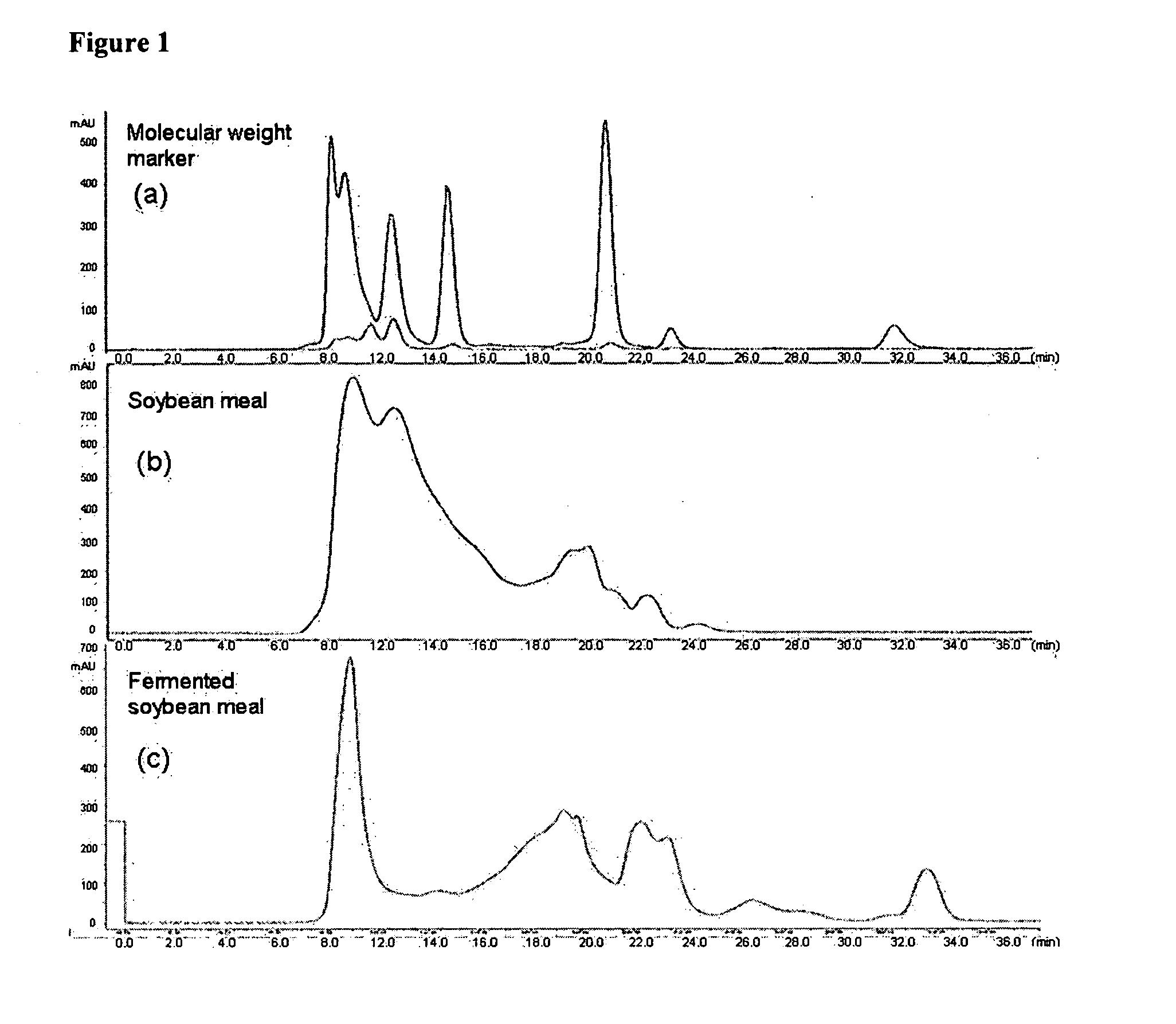Fermented soybean products and methods of producing them
- Summary
- Abstract
- Description
- Claims
- Application Information
AI Technical Summary
Benefits of technology
Problems solved by technology
Method used
Image
Examples
example 1
Isolation and Identification of Strain with Excellent Protease Productivity
[0030]Bacillus subtilis with excellent protease productivity useful for microorganisms in livestock feed was isolated from traditional soybean malt by converting high-molecular weight soybean protein into low-molecular weight peptides via fermentation with microorganisms. 1 g of soybean malt was suspended in 10 mL of sterilized saline so that it was diluted in a ratio of 1×10−1 to 1×10−5. 100 μg / mL of the dilution obtained thereby was applied to a MYP culture medium (Beef extract 1 g / L, peptone 10 g / L, D-mannitol 10 g / L, sodium chloride 10 g / L, Phenol Red 0.025 g / L), followed by incubation at 37° C. for 24 hours. After the incubation, colonies appearing on the solid medium were examined with a microscope for isolation, and such isolated strains were cultured in a SK agar medium (skim milk 10 g / L, NaCl 0.24 g / L, yeast extract 0.75 g / L, anhydrous potassium phosphate (KH2PO2) 1.24 g / L, magnesium sulfonate (MgSO4...
example 2
Determination of Optimized Fermentation Conditions of Bacillus Subtilis GR-101 and Aspergillus Oryzae GB-107 (KCTC 10258BP) Suitable for Solid Fermentation of Soybean Meal
[0031]Bacillus subtilis GR-101 and Aspergillus oryzae GB-107 (KCTC 10258BP) were examined for their optimized fermentation conditions depending on water content upon fermentation of soybean meal. To perform this, crude protein content, cell count of microorganisms and enzyme activity were examined.
[0032]First, soybean meal having an initial water content of 13% was adjusted to a water content of 30%, 40%, 50% or 60%. Next, 500 g of each soybean meal sample was introduced in a stainless steel sieve and the sieve was covered with aluminum foil, followed by cooking at 75° C. for 30 minutes and cooling to 30° C. Then, seeds of Bacillus subtilis GR-101 and Aspergillus oryzae GB-107 (KCTC 10258BP) were taken each in an amount of 1% per 500 g soybean meal, each containing 1×109 and 5×108 / ml microorganisms) and then spraye...
example 3
Determination of Enzyme Activity
[0040]A number of microorganisms were isolated from traditional Korean soybean paste (Mae-Joo) and tested for amylase and protease activity. The following table shows the actual value of amylase and protease activity of the selected microorganisms.
Amylase (U / g)Protease (U / g)A. oryzae GB-107300 and greater15 and greaterB. subtilis GB-101 30 and greater70 and greater
[0041]Protease activity was determined by the following method:
Assay for Proteolytic Activity using Azocasein
[0042]Azocasein is a chemically modified protein that was designed as a substrate for quantitative assays of proteolytic enzyme activity. It is prepared by chemically adding sulfanilamide groups to the milk protein casein. The sulfanilamide groups, which are orange, are covalently linked to the peptide bonds. Reaction mixtures are set up using azocasein as the substrate. They are then incubated under the conditions chosen for the experiment. As the proteolytic enzyme hydrolyzes peptid...
PUM
| Property | Measurement | Unit |
|---|---|---|
| Water content | aaaaa | aaaaa |
| Water content | aaaaa | aaaaa |
| Water content | aaaaa | aaaaa |
Abstract
Description
Claims
Application Information
 Login to View More
Login to View More - R&D
- Intellectual Property
- Life Sciences
- Materials
- Tech Scout
- Unparalleled Data Quality
- Higher Quality Content
- 60% Fewer Hallucinations
Browse by: Latest US Patents, China's latest patents, Technical Efficacy Thesaurus, Application Domain, Technology Topic, Popular Technical Reports.
© 2025 PatSnap. All rights reserved.Legal|Privacy policy|Modern Slavery Act Transparency Statement|Sitemap|About US| Contact US: help@patsnap.com


